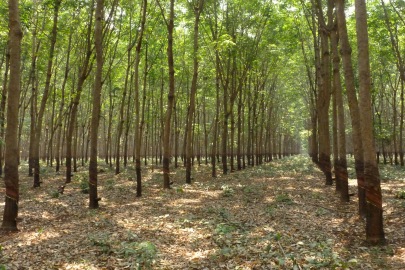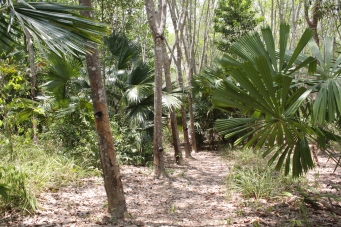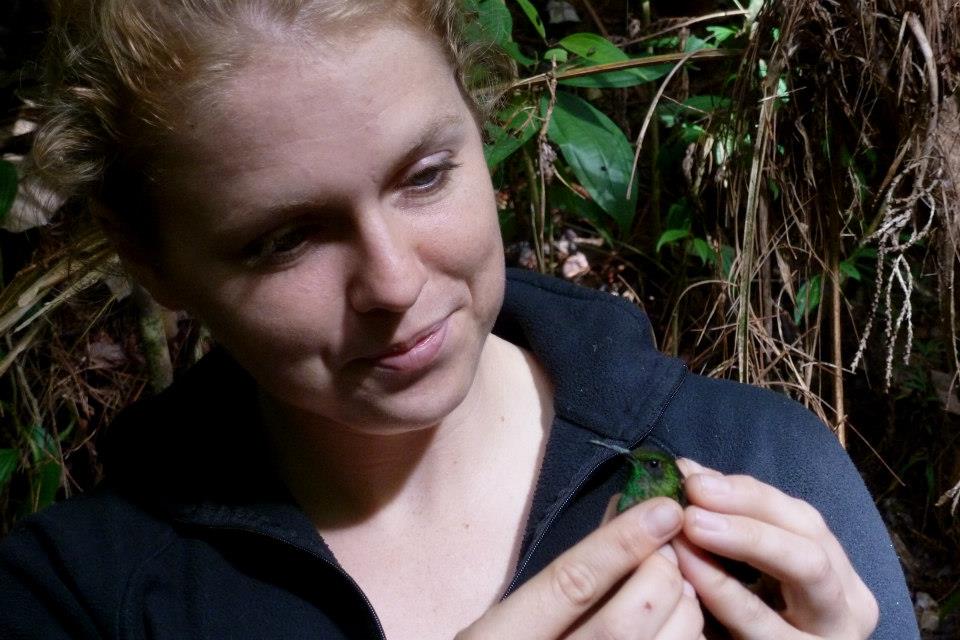
My research focuses on biodiversity conservation, land use change and agriculture, particularly in the tropics. I use field studies and existing data sets to investigate the outcomes of management decisions and land use change for biodiversity, climate change and livelihoods. I use ecological, economic and spatial analytical approaches, including assessments of costs and benefits of different scenarios.
I aim to provide evidence for decision-making and planning for biodiversity conservation, environmental protection and sustainability. As part of this aim, I completed a policy internship with the Environment Research Team at the National Assembly for Wales, UK
Projects
NERC-IIASA Collaborative Fellowship – addressing the unintended consequences of tropical forest restoration
I currently hold a fellowship at Bangor University, working with Dr Isabel Rosa and Prof. Julia Jones, and collaborating with the Ecosystem Services and Management group at IIASA, Austria. My research focusses on understanding the potential consequences of forest restoration policies in tropical regions, where deforestation is still actively underway, driven by social and economic pressures. I work to improve land-use modelling methods and scenarios, and apply them to critical current questions around forest restoration.
Post-doctoral research – tropical peatland restoration
I worked as a Post-Doctoral Research Associate with Professor Jane Hill at the University of York. Our collaborative UK-Indonesia project studies tropical peatlands in Sumatra, Indonesia. Tropical peatlands were originally covered in forest, supporting unique biodiversity and storing huge stocks of below-ground carbon. In Indonesia, deforestation and drainage of peatlands to make way for plantations of oil palm and acacia caused widespread fires and toxic haze. Peatland restoration is now a priority in Indonesia.

Our project investigates the consequences of tropical peatland degradation and restoration for biodiversity, greenhouse gas emissions and livelihoods. I coordinate the work of our multi-disciplinary team, run a program of field data collection and analysis, and conduct modelling of forest connectivity and restoration scenarios. Find out more about our progress at the project website.
PhD research – habitat loss, biodiversity and economics in the Indo-Burma biodiversity hotspot
My PhD work, supervised by Paul Dolman and David Edwards was centred on the Indo-Burma biodiversity hotspot, where globally endangered species and forest ecosystems are being threatened by demand for timber and agricultural land. The expansion of rubber plantations onto forest is a key threat in the region.

Industrial-scale rubber monoculture in Cambodia
(Photo by Eleanor Warren-Thomas)
This work had a number of strands, including:
- the importance of rubber plantations as a driver of land use change and biodiversity loss (link to paper and media articles);
- the economic and carbon emissions outcomes of timber extraction and forest conversion to rubber, and the sufficiency of carbon finance incentives for forest protection (link to paper and media article); and
- the role of agroforestry in improving the hospitability of rubber plantations for wildlife, while providing livelihood benefits and maintaining rubber production.

Rubber agroforest in Southern Thailand
(Photo by Eleanor Warren-Thomas)
MSc research – ground beetle and moth diversity in Beijing’s new mountain forests
Northern China lost almost all primary forest cover during the 20th century. In response to resulting flooding and soil erosion, especially in mountainous areas, forest cover was re-established through planting and natural forest regeneration. I assessed the invertebrate diversity of secondary and plantation forests in northern China for my MSc thesis research, working with Jan C Axmacher and Yi Zou at UCL. I surveyed carabids and moths in several forest types (planted and naturally regenerated) in Mentougou District, Beijing, and found that each forest type contained distinct communities, contributing to landscape-scale invertebrate diversity (links to papers here, here and here).
Undergraduate research – amphibian communities in fire-affected forests of the Peruvian Amazon
Amazonian forests are increasingly influenced by drought and fires. As part of a small team led by Mary Menton and supported by an RGS Geographical Fieldwork Grant I surveyed forest structure and amphibian communities in fire-affected forests in Madre de Dios, Peru. We found differences in amphibian community composition between bamboo dominated forest and terra-firme forest stands, and found that fire-affected forests supported very substantial amphibian diversity (link to paper).
I have also worked on these projects:
- sustainable multi-use management of brazil nut concessions in the Peruvian Amazon (CIFOR) – see blogs and videos here, here and here;
- amphibian diversity on floating meadows in Pacaya-Samiria National Park, Peru (Katy Upton, DICE, University of Kent) – see blog here; and
- forest carbon stock surveys in Cusuco National Park, Honduras (Operation Wallacea).

Publications
2020
Ward, C., Stringer, L.C., Warren‐Thomas, E., Agus, F., Hamer, K., Pettorelli, N., Hariyadi, B., Hodgson, J., Kartika, W.D., Lucey, J. and McClean, C. (2020). Wading through the swamp: what does tropical peatland restoration mean to national‐level stakeholders in Indonesia? Restoration Ecology, 28(4), pp.817-827. Full text
Lopes, M., Frison, P.L., Crowson, M., Warren‐Thomas, E., Hariyadi, B., Kartika, W.D., Agus, F., Hamer, K.C., Stringer, L., Hill, J.K. and Pettorelli, N. (2020). Improving the accuracy of land cover classification in cloud persistent areas using optical and radar satellite image time series. Methods in Ecology and Evolution, 11(4), pp.532-541. Full text
2019
Zou, Y., Sang, W., Bai, F., Brennan, E., Diekman, M., Liu, Y., Li, L. Marples, A., Shi, H., Sui, Z., Sun, X., Wang, C., Wang, X., Warren‐Thomas, E., Yang, X., Yu, Z., Axmacher, J.C. (2019) Large‐scale α‐diversity patterns in plants and ground beetles (Coleoptera: Carabidae) indicate a high biodiversity conservation value of China’s restored temperate forest landscapes. Diversity and Distributions, 25(10), pp.1613-1624. Full text
Warren‐Thomas, E., Nelson, L., Juthong, W., Bumrungsri, S., Brattström, O., Stroesser, L., Chambon, B., Penot, É., Tongkaemkaew, U., Edwards, D.P. and Dolman, P.M. (2020) Rubber agroforestry in Thailand provides some biodiversity benefits without reducing yields. Journal of Applied Ecology, 57(1), pp.17-30. Full text
2018
Crowson, M., Warren-Thomas, E., Hill, J.K., Hariyadi, B., Agus, F., Saad, A., Hamer, K.C., Hodgson, J.A., Kartika, W.D., Lucey, J., McClean, C., Nurida, N.L., Pratiwi, E., Stringer, L.C., Ward, C. & Pettorelli, N. (2018). A comparison of satellite remote sensing data fusion methods to map peat swamp forest loss in Sumatra, Indonesia. Remote Sensing in Ecology and Conservation. doi:10.1002/rse2.102 Full text
Warren-Thomas, E.M., Edwards, D.P., Bebber, D.P., Chhang, P., Diment, A.N., Evans, T.D., Lambrick, F.H., Maxwell, J.F., Nut, M., O’Kelly, H.J., Theilade, I. & Dolman, P.M. (2018). Protecting tropical forests from the rapid expansion of rubber using carbon payments. Nature Communications. 9, 911. doi:10.1038/s41467-018-03287-9 Full text
2017
Rockwell, C.A., Guariguata, M.R., Menton, M., Quispe, E.A., Quaedvlieg, J., Warren-Thomas, E., Silva, H.F., Rojas, E.E.J., Arrunátegui, J.A.H.K., Vega, L.A.M., Hancco, R.Q., Vera, O.R., Tito, J.F.V., Panduro, B.T.V. & Salas, J.J.Y. (2017) Spatial distribution of Bertholletia excelsa in selectively logged forests of the Peruvian Amazon. Journal of Tropical Ecology. 1-14. doi:10.1017/S0266467416000614. Abstract
2016
Zou Y., Sang W., Warren-Thomas, E., Axmacher J.C. (2016) Geometrid moth assemblages reflect high conservation value of naturally regenerated secondary forests in temperate China. Forest Ecology and Management. 374, 111–118. doi:10.1016/j.foreco.2016.04.054 Abstract
2015
Rockwell, C.A., Guariguata, M.R., Menton, M., Arroyo Quispe, E., Quaedvlieg, J., Warren-Thomas, E., Silva, H.F., Rojas, E.E.J., Arrunátegui, J.A.H.K., Vega, L.A.M., Vera, O.R., Hancco, R.Q., Tito, J.F.V., Panduro, B.T.V. & Salas, J.J.Y. (2015) Nut Production in Bertholletia excelsa across a Logged Forest Mosaic: Implications for Multiple Forest Use. PLoS ONE. 10 (8): e0135464. doi:10.1371/journal.pone.0135464. Full text
Warren-Thomas, E., Dolman, P.M. & Edwards, D.P. (2015). Increasing Demand for Natural Rubber Necessitates a Robust Sustainability Initiative to Mitigate Impacts on Tropical Biodiversity. Conservation Letters. 5 (4), 230-241. doi:10.1111/conl.12170 Full text
Second most accessed paper published by Conservation Letters in 2015, >3,500 full text views or downloads.
Zou, Y., Sang, W., Wang, S., Warren-Thomas, E., Liu, Y., Yu, Z., Wang, C. & Axmacher, J.C. (2015). Diversity patterns of ground beetles and understory vegetation in mature, secondary, and plantation forest regions of temperate northern China. Ecology and Evolution. 5 (3), 531–542. doi: 10.1002/ece3.1367 Full text
2014
Warren-Thomas, E., Zou, Y., Dong, L., Yao, X., Yang, M., Zhang, X., Qin, Y., Liu, Y., Sang, W. & Axmacher, J.C. (2014). Ground beetle assemblages in Beijing’s new mountain forests. Forest Ecology and Management. 334, 369–376. doi:10.1016/j.foreco.2014.09.022 Abstract
Upton, K., Warren-Thomas, E., Rogers, I., Docherty, E. (2014). Amphibian Diversity on Floating Meadows in Flooded Forests of the Peruvian Amazon. Herpetological Review. 45 (2), 209–212. Full text on ResearchGate
2013
Warren-Thomas, E., Menton, M., Huamán, J., Frisancho Vargas, R., Wadley, E., Price, N., Axmacher, J.C. (2013). Frog Communities in Fire-Disturbed Forests of the Peruvian Amazon. Herpetological Bulletin. 123, 14-24. Full text